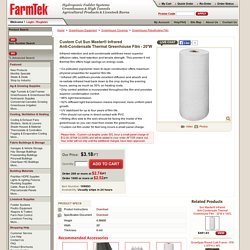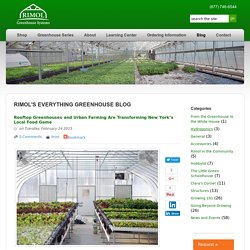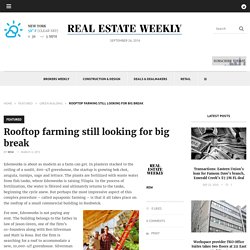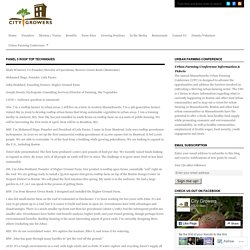

How to Grow Vegetables in a Greenhouse. At the end of the fall harvest season, most people clean up their garden beds, put away their gardening tools, and settle in by the fire for a cold, dormant winter.

But the people that know how to grow vegetables in a greenhouse will continue to plant, harvest and enjoy fresh produce all winter long! Wouldn’t you love to have a fresh, home grown tomato even in the bitter cold of winter? Even if tomatoes are not your thing, you can definitely save money on groceries by continuing your gardening through the winter months. Before You Get Started in Your Greenhouse Whether you are a prepper or a homesteader, learning how to grow vegetables in a greenhouse is a great skill to learn. Obviously you want to grow what you and your family will actually eat. Department of Horticulture Science. Construction and Design Tomato The Greenhouse & Processing Crops Research Centre in Harrow, Ontario, Canada: Rick's Vegetable Resource Page: There is now a bulletin on calibrating injectors for greenhouse tomatoes University of Arizona: Growing Tomatoes Hydroponically DeRuiter website: Insects.

Department of Horticulture Science. Construction and Design Tomato The Greenhouse & Processing Crops Research Centre in Harrow, Ontario, Canada: Rick's Vegetable Resource Page: There is now a bulletin on calibrating injectors for greenhouse tomatoes University of Arizona: Growing Tomatoes Hydroponically DeRuiter website: Insects Beneficial insectary home page Biological Control Virtual Information Center: Cornell Univ.

Greenhouse Supplies.
Custom Cut Sun Master® Infrared Anti-Condensate Thermal Greenhouse Film - 20'W. Shipping Estimator We calculate the best shipping rate to the entered zip code—this is only an estimate and charges may vary at checkout.

Due to FarmTek's shipping efficiencies, ordering multiple items may reduce your per item shipping cost. Please note transit and delivery times do not include weekends or holidays. You will be able to select your preferred shipping option during checkout. Enter your postal code to calculate your shipping charge: Greenhouse Plastic : Sun Selector Clear IR AD Greenhouse Film, 4 year 6mil, per sq.ft. Features: We custom cut your film to any length that adds up to over 500 square feet (e.g 20' x 25' = 500 sq.ft)IR - Infrared additive retains the infrared heat, reducing heating costs and provides 6-8 degrees warmer temps inside the house compared to regular UVA filmAD - Anti-Drip (sometimes called AC anti-condensation) prevent condensation which can lead to mold, mildew and uneven light distribution.UVA - Ultraviolet protection prevents sun deterioration and ensures the film lasts at least 4 years.Anti-Dust protection helps repel dirt from the surface instead of creating static that attracts dirt and impairs light.5-Layer Technology for strength and versatility88% light transmission, 25% light diffusion, 80% thermicity (IR Additive helps prevent heat loss).4 Year Warranty.Please note: This product is custom made to your exact specifications, please allow an average of 5-7 business days before shipping.

Also note: This is a custom cut item made to your individual specifications. Farm the Rooftops – The Dirt. In many cities, rooftops that can handle the soil, water, and plant loads are being put to productive use, attacking food insecurity and building communities in the process, said Leigh Whittinghill, Michigan State University, at the Green Roofs for Healthy Cities conference in Philadelphia.

Still, there are some major barriers preventing more widespread rooftop farming, namely just finding enough low-cost, structually-sound roofs to plant; obstructive municipal zoning; and issues with “managing fertility.” There are also challenges with fertilizer runoff and economic profitability. Rooftop Agriculture Isn’t Easy. Greenhouses Grow Possibilities for Urban Building Owners. A green, or “living,” roof is one that is partially or completely covered with vegetation.

Forward-thinking cities are looking to green roofs and gardens to help reduce building temperatures, filter pollution, lessen pressure on sewer systems, and reduce the heat island effect. Toronto is one of these forward-thinking cities. In January 2010, Toronto began offering industrial and commercial building owners up to $100,000 per year to make so-called “green roofs” of their rooftops. Moreover, Toronto became the first city in North American to require green roofs for developments over a certain size. Starting in 2010, large, new urban developments had to devote 20-60 percent of available roof space to a green-roof construction. Greenhouses Are Providing Opportunities For Urban Farming. Until recently, urban agriculture has been a hard sell.

Gardens require space, and that is hard to come by in places like New York City where real estate prices are skyrocketing and even finding a parking spot can take hours. While from the street urban farming may not appear to be a viable option, a bird’s eye view of the city provides an entire new take on what constitutes “farmable” space. Finding the Space New York City has 235 skyscrapers and roughly one billion square feet of roof area. That is over 11 percent of the total area of the city, which is more than any city in the world aside from Hong Kong. Forward-thinking companies are realizing that this is prime agricultural real estate that is being mostly underutilized. Rooftop farming still looking for big break. Edenworks is about as modern as a farm can get.

In planters stacked to the ceiling of a sunlit, 800-s/f greenhouse, the startup is growing bok choi, arugula, turnips, sage and lettuce. The plants are fertilized with waste water from fish tanks, where Edenworks is raising Tilapia. In the process of fertilization, the water is filtered and ultimately returns to the tanks, beginning the cycle anew. But perhaps the most impressive aspect of this complex procedure – called aquaponic farming – is that it all takes place on the rooftop of a small commercial building in Bushwick. PANEL 5 Roof Top Techniques. PANEL 5 Roof Top Techniques Mark Winterer, Co-Founder/Director of Operations, Recover Green Roofs (Moderator) Mohamed Hage, Founder, Lufa Farms.

Building Greenhouse Farms on Urban Roofs. Rooftop Greenhouses From Rough Brothers. Roof-top greenhouses bring a unique set of design challenges to any greenhouse project. Rough Brothers has the experience as well as a talented team in place to bring about a fully functional educational roof-top greenhouse that will compliment any campus. How to Design a Year-Round Solar Greenhouse. What is a solar greenhouse? Don’t all greenhouses use the sun? Well yes, but a solar greenhouse uses the sun’s energy not only for growing, but also to provide all of the greenhouse’s heating needs.
Premium quality locally grown vegetables and herbs. Our flagship greenhouse, built in 2011, was the first ever commercial scale greenhouse facility of its kind built in the United States. The rooftop greenhouse, designed, built, owned and operated by Gotham Greens, measures over 15,000 square feet and annually produces over 100,000 pounds of fresh leafy greens. The greenhouse remains one of the most high profile contemporary urban agriculture projects worldwide.
The Engineering Behind Rooftop Greenhouses. Twenty years ago, none of us would ever have envisioned dozens of greenhouses on the roofs of random buildings in cities like New York, Chicago and San Francisco. And we continue to see them popping up in many urban areas around the United States and Canada. Colorado-based Nexus Greenhouse Systems has been erecting growing structures for ornamentals growers, garden center retailers and university researchers for the past 50 years. Although Nexus has been building rooftop greenhouses for decades, the last five to 10 years has really shown an uptick in interest, said Jeff Warschauer, VP of sales for Nexus. Pictured: The greenhouse on top of the Arbor House apartment building in the Bronx, New York. “Urban agriculture is here to stay,” he said. As we hear about more and more rooftop greenhouses adding to the skyline of many cities, we were wondering about the differences and challenges that come with building these unique growing structures versus greenhouses built on the ground.
Building Considerations for Commercial Rooftop Greenhouses. Rooftop greenhouses are becoming a more popular option for commercial growers interested in tapping into the “buy local” market for urban centers. They take up no additional land and are ideal for urban areas or small lots where a traditional greenhouse is not possible or practical. Roofs can be considered as wasted surfaces, and represent an important area of potential growth for urban agriculture. The green roof movement can also be incorporated into greenhouse roofs. Controlled Environment Greenhouses (CEA)
The increased consumer interest in eating healthier and knowing where their food comes from has driven the organic and locally grown food movements. This movement has increased the use of greenhouses to provide controlled environments best suited to produce the vegetables, herbs, fruits or even fish to fill this demand. CEA has decreased the carbon footprint of food production by locating the greenhouse nearer to the consumer and increasing production per square foot.
As this market has matured different technologies of growing these food products has emerged. Nexus has become a leader in providing the right conditions to use these technologies for the benefit of the indoor farmer. Building Small Garden Hoop Houses out of Electrical Conduit. Hoop House Open Source Hub. As part of One Community’s four-phase strategy and global change methodology, we’ve created the following page for open source project-launch blueprinting affordable and large-scale hoop houses that will be constructed as part of our large-scale gardening strategy that, when combined with beginning the One Community food forest, is Phase I of the planting component of our food infrastructure.
Phase II will be construction of larger and more permanent food structures. We will use hoop houses to expand both our early and late growing seasons by establishing seedlings earlier in the spring and growing a second fall crop of leafy greens. Hoop House Construction for New Mexico: 12-ft. x 40-ft. Hoop House. Ellipse Circumference Calculator. Hoop House How-To - Kerr Center. Necessity Leads to Hoop House Invention.
During my tenure with the Noble Foundation as a horticulture consultant, I've had the opportunity to meet many innovative growers. I met one such person this past September on the farm of Tod and Jamie Hanley at a hoop house conference sponsored by the Kerr Center for Sustainable Agriculture. More than 100 participants had gathered to erect a 17-foot by 102-foot hoop house (aka high tunnel). Many hands made quick work. Building a Greenhouse for Chicken-scratch. Wiggle Wire and Double Layer Greenhouses. This time of year the wind is whipping, the temperatures are plummeting and folks are asking about double layer poly coverings- the coverings of plastic film that we have on our greenhouses here at Bright Agrotech.
We’ve been told over the years that what we’re doing doesn’t work, that poly can’t handle the windload, the snowload or the abuse that Wyoming winters tend to dish out. Adam J. Fyall - Greenhouse Effect. No Winter at Whitewater Gardens Farm: Geothermal Greenhouse Project in Altura, MN. As residents of the Midwest know, the growing season is painfully short. When it’s twenty below, what else can you do besides go to the supermarket and buy tomatoes shipped from thousands of miles away? ManualforVirtualGrower1.1. Fsa 6051. Small greenhouse. Part I: F-H - Construction & Repair: F-J - Databases, Courses, Textbooks, Lessons, Manuals, Guides, Publications, Technical Reports, Videos, Movies, Calculators, Spreadsheets, Applets, Animations, etc. Greenhouse Cost Estimates » Commercial Horticulture. Solar Sunspaces and Greenhouses. Dozens of free design guides and plans for dozens of sunspaces and greenhouses you can build.
Attached sunspaces can be a good way to solar heat your house, provide some additional living space, plant growing space, a place to read the newspaper and look at the views, and a place to hang the laundry for solar drying. Introduction to Greenhouse Efficiency and Energy Conservation - eXtension. Contents. Geothermal Heat for Greenhouses - eXtension.